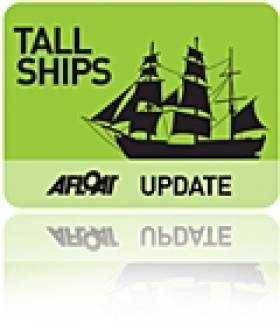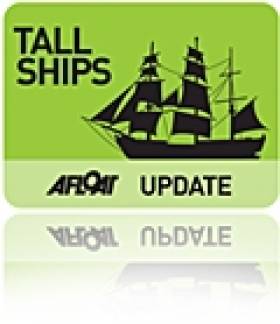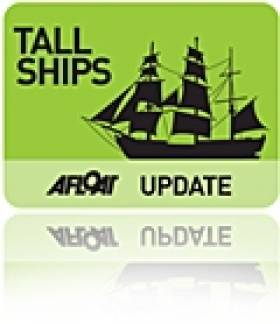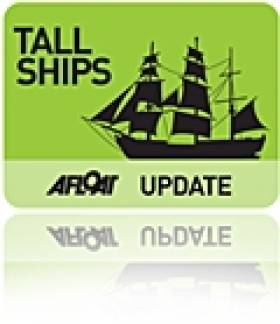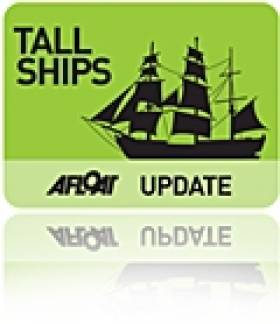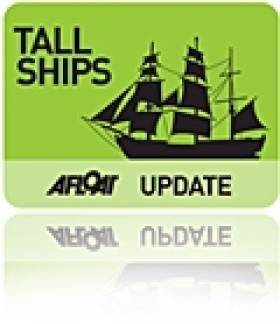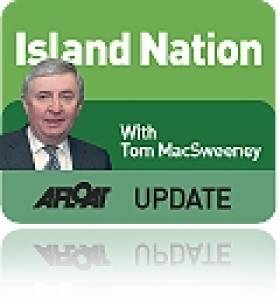Displaying items by tag: Tall
Sail Training Fleet to Race to Weymouth and Portland
The charities running the vessels use Sail Training to provide life changing opportunities for young and disabled people from across the UK. Weymouth and Portland National Sailing Academy (WPNSA) is working together with the Association of Sail Training Organisations (ASTO) to organise this spectacular youth event.
The ships will depart London on 11th June, 2012 and race to Weymouth and Portland, arriving on 15th June, 2012. On the 16th June, HM The Queen's representative in Dorset, the Lord Lieutenant, Val Pitt-Rivers will start another race within Weymouth Bay by firing a cannon from the Nothe Fort. The races will be followed with a prize-giving at the Academy in the evening of the 16th.
John Tweed, Chief Executive at the Weymouth and Portland National Sailing Academy, commented, "This is a first class opportunity to link young people from Dorset with London in such a positive youth adventure. The sailing will be just a small part of the overall experience; the young people involved will also gain valuable life-skills to benefit them for a long time afterwards. It's a very exciting project and one we're very pleased to be on board with.
The event has been strongly supported not only by the Sailing Academy working closely with ASTO; we have also received enormous help from Portland Marina and Portland Harbour Authority.
The spectacle provided by these remarkable vessels will be a great opportunity for people in Weymouth and Portland to come and enjoy – and start to build excitement for the very special sailing events taking place a few weeks later."
There are 60 places available for young people from Dorset to take part in this adventure. Schools are being contacted about this opportunity, but anyone interested in taking part should contact ASTO on 02392 503 222. To find out more about Sail Training, take a look at www.uksailtraining.org
New German Tall Ship Launched
Already on the day before the ceremonies, an unique welcome comitee will assemble on River Weser to welcome the two tall ships. Several traditional ships, tugs and other boats will expect Alex I and Alex II on Friday September 23rd, when both windjammers are going to sail up River Weser passing Seebäderkaje about 2.15 p.m. Afterwards, the Ships will enter Neuer Hafen. After mooring there will be a skipper party with live music at the party pavilion on the pier.
The charitable DSST, celebrating its 25th anniversary this year, operates the tall ship Alexander von Humboldt with the goal to familiarize young and young at heart people to experience traditional seamanship on a historic ship. The goal will remain the same with Alex II. The three-masted ship was built at BVT Brenn- und Verformtechnik Bremen, a part of Rönner Group.
Tall Ships 2011: Young Sailors 'Buoyed' with their Successes
Not only has their ship, The Moosk been placed third in class in the first leg of the race, but they were awarded the youngest crew trophy and won their skipper's weight in food and drink having been the first 2011 tall ship to arrive at Unst.
Eighteen of the St Budeaux School's 14-19 year olds have been involved in the international event which started in Waterford, Ireland and included ports of call at Greenock, Scotland and Lerwick in the Shetland Isles, continuing to Stavanger in Norway before finally dropping anchor at Halmstad in Sweden at the beginning of August.
The 18 students who successfully completed a rigorous selection before finally becoming crew for a section of the race on the tall ship Moosk were split into three groups.
The first six sailed from Plymouth to Waterford where six more Marine Academy students took over and raced in the first leg, Race One, from Waterford to Greenock. Once in Greenock, the crew changed again and the final six students sailed to Lerwick before returning home this weekend.
The young sailors are buoyed up with their successes.
In their latest messages on Facebook they say: "Wahoo just arrived in Lerwick, we've had an amazing time already. We've been to Unst and rounded Mukkle Flugga, the most northern point in Britain. We won the Captain's Weight in Unst - proud - and had a parade with Vikings. All in all it's been amazing so far."
Marine Academy Plymouth is planning a celebration evening in September for the students who joined hundreds of other youngsters crewing ships from Russia, Belgium, Germany, Sweden, Lithuania, Poland, Norway, Denmark, Colombia, Spain and France.
Helen Mathieson principal at Marine Academy Plymouth said: "The success of all our young people taking part in the fantastic event which is the Tall Ships Race is a very fitting end to the Marine Academy Plymouth's first year.
"All the students who have taken part have learned so much - about themselves, what they can achieve and how they can make success happen by working with others. All of them have been part of winning teams and have felt the joy of making it happen for themselves; their horizons have been widened by the whole experience."
Tall Ship Runs Aground off Scotland
The 100ft-long tall ship Irene of Bridgwater, with 10 people on board, became stuck in Lamlash Bay on its way to port at Greenock.
Clyde Coastguard said the ship was expected to refloat at high tide in the early hours of this morning. There was no danger to anyone on board.
Greenock is hosting the second stage of the race, following Waterford, Ireland. BBC News has more HERE.
Dunmore East Bids TallShips Farewell
As the Russian 'A' class Mir passed the LE Aoife off Dunmore East in mid-morning, the largest tall ship of the festival headed the start of the Parade of Sail, writes Jehan Ashmore.
Crowds left their cars in fields outside Dunmore East and descended into the harbour and surrounding headlands to witness the highlight of the four-day festival. Adding to the scene were the numerous leisure-craft, yachts and intrepid kayakers that gathered to greet the procession which took some two hours to pass the fishing harbour.
No sooner had the fully-rigged ship Mir had slipped beyond the anchored naval vessel that the gaff schooner Johanna Lucretia, under full sail came closer into view. She was closely followed by the Ocean Youth Trust Scotland's Bermudan cutter Alba Explorer.

The Russian 'A' class Mir passing the LE Aoife off Dunmore East. Photo: Jehan Ashmore
Of all the 45 tallships participating the Columbian Navy's barque ARC Gloria presented the most colourful entrant. She proudly flew a large horizontal tricolor of yellow, blue and red representing the South American nation.
When it came to the turn of the Europa to pass the LE Aoife, the tug Bargarth gave a wonderful send-off with the traditional display of water jets shooting sky-high, nearly reaching the top of the three-masted barque.
Marking the tail-end of the parade was the Jubilee Sailing Trust's Lord Nelson, another barque that departed the estuary with the Hook Head Lighthouse forming a majestic backdrop.
At this stage several of the large tallships could be seen on the far horizon in preperation to the start of the first race leg of this years Tall Ships Races....next port of call Greenock!
- Waterford
- ship
- Dunmore East
- Lord Nelson
- Waterford Estuary
- LE Aoife
- Sail Training International
- Jubilee Sailing Trust
- Tug
- Hook Head
- Tall
- JOHANNA LUCRETIA
- TallShips
- Waterford Harbour
- JST
- Europa
- Fullyrigged ship
- STI
- ARC Gloria
- Hook Head Lighthouse
- Mir
- Gaff schooner
- Ocean Youth Trust Scotland
- Bermudan cutter
- Alba Explorer
- Columbian Navy barque
- Bargarth
- Fastnet Shipping
Yacht Towed to Harbour after Collision with Tall Ship
The lifeboat launched at 2.38am and was on scene at 3.32am. Reports had been received from Dublin Coast Guard that the yacht was in urgent need of assistance after being damaged on collision with another vessel and was taking on water.
Arriving on scene the volunteer lifeboat crew saw debris in the water and noticed a considerable amount of damage to the yacht on the port side. They immediately assessed the state of the crew on both vessels, fifteen were onboard the Tall Ship and a single crewmember onboard the yacht.
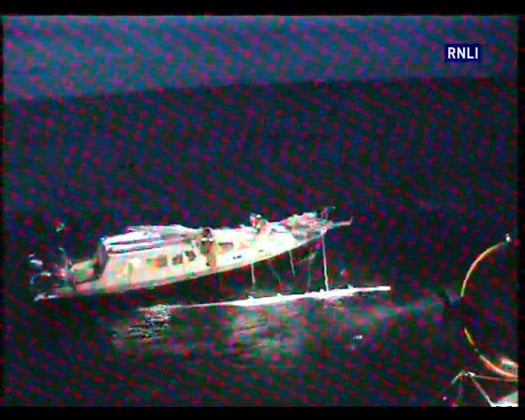
The casualty vessel - Photo: RNLI
On establishing there were no injuries three lifeboat crew boarded the yacht and cleared some of the debris from the water. Due to the damage the lifeboat crew took the yacht under tow back to Rosslare Harbour and the Tall ship made its way on to Waterford.
The Irish Coast Guard Helicopter from Waterford arrived on scene and provided a strong search light overhead for the crews to work in. Conditions were good with a slight swell.
Commenting on the callout, Rosslare Deputy Launching Authority Dave Maloney said, " While there was damage to one of the vessels thankfully there was no serious injury to any person. The priority for the lifeboat crews was to ensure that there was no danger to anyone and that the vessel was taken back to shore as quickly as possible due to the threat of sinking.”
Mid-Week Wrap up: Fireballs, Lasers, Three Peaks, Calves Week, VOR and Life Saving Honours
An Irish debutant leads the fleet after four days of competition in the Three Peaks Yacht Race. Last night Glen Ward's crew were climbing Ben Nevis.
Half the country is heading for the Tall Ships.
400 are now expected for next week's Volvo Dun Laoghaire Regatta.
There's only a month to Calves week in West Cork. The race programme (plus a sponsor) has been unveiled.
One year to go to the finish of the Volvo Ocean race. Galway gets serious.
Who should be June's Sailor of the Month? Water Rat asks are two medals a realistic expectation from London?
And finally, a German Honour on an Irish Lifesaver. Well done Frank Nolan.
All these stories – and more – on our home page this morning!
Tall Ship Interests Plan Replacement for Asgard II
Ireland could yet have a Tall ship to replace the Asgard II and the Lord Rank, if a new sailing group formed to press for a replacement is successful. The news is in this morning's Irish Times newspaper. Groups representating different interests from maritime to tourism to economic are getting together for a special conference on March 26th in Dublin Port. The full Irish Times story is HERE. Next week in Afloat magazine's March/April issue an article called 'Tall Order for Ireland' gives all the details on the conference. It includes a 'call for contributions' from key stakeholders who would support a Tall Ship for Ireland. More details HERE. And in a separate article WM Nixon looks at the realities of national sail training in the 21st Century. This new move on a replacement seems to have entirely appropriate timing; Asgard II was commissioned in Arklow 30 years ago this week, on March 7, 1981.
Looking for further reading on Tall Ships in Ireland? Click the links below:
Click this link to read all our Tall Ships Stories on one handy page
Previewing Ireland's Tall Ships 2011 Season
Can Ireland Get a New Tall Ship?
Now There is None
What a magnificent sight it was as the three Tall Ships, each flying the Tricolour, headed the fleet of the gracious ships of sail from all over the world.
How different it will be in July when the world's Tall Ships again parade down the Suir. There will be no Irish national sailing ship to lead the parade. A number of private Irish entries are expected at Waterford from June 30–July 3 amongst the 70 vessels from around the world when the city has the honour starting the race. In 2005 about half-a-million people visited the city while the Tall Ships were there.
The lack of a national tall ship is another example of governmental maritime neglect, directly due to the decision of former Defence Minister Willie O'Dea, T.D. After the sinking of ASGARD he publicly committed the Government to its replacement, but after receiving insurance compensation money for its loss, he put the money into coffers of the Department of Finance and closed down the national sail training programme. There was a big difference between what he promised and what he did, a disregard for the maritime sphere which it is hard to forgive. I also recall how former Taoiseach Bertie Ahern did not visit Waterford during the 2005 race, when it was the biggest tourist event in the country. When I broadcast my report expressing astonishment at this snub government sources and Fianna Fail didn't like it. Truth in the news can be painful!
The organisers made contacts about the DUNBRODY, which continues to earn income at the New Ross quayside where it is moored as a tourist attraction and with the JEANIE JOHNSTON, moored at the Dublin Docklands.
However, neither will be taking part, the organisers have confirmed, tough they said that it was expected that about 100 young Irish trainees would sail aboard tall ships in the race, half of them with funding support from local authority, business and other sources. A group of Irish sailors have also indicated they are making arrangements to charter a UK-registered vessel the JOHANNA LUCRETIA for the event.
Once again the Irish Government has sunk to the bottom where maritime matters are concerned.
It was announced this week in Waterford that Fáilte Ireland has made a significant financial and marketing commitment to this year's event, though the financial figure was not disclosed .A free festival programme will feature street acts; comedy; international and home-grown artists, nightly fireworks, an artisan food village and an atmosphere which the organisers say "will thrill people of all ages and nationalities."
• This article is reprinted by permission of the EVENING ECHO newspaper, Cork, where Tom MacSweeney writes maritime columns twice weekly. Evening Echo website: www.eecho.ie



























